Psychological stress among Nigerian undergraduate students during the COVID-19 pandemic
Ubani BC1a, Akpabio AA1, Akpanekpo EI2a, Umoh VA1, Dike FO1, Effiong JH3
Abstract
Background: Coronavirus disease (COVID-19) global pandemic has been linked with a high level of psychological stress from the associated lockdown policy by the government. University students are amongst the high-risk groups for developing COVID-19 related stress due to several factors.
Objective: This study aimed to determine the prevalence of psychological stress among Nigerian undergraduates during the COVID-19 pandemic lock down and assess predictors of moderate and high psychological stress.
Methods: Data from a cross-sectional sample of 471 undergraduate students in Nigerian universities (aged 18 – 42) was utilized to determine the prevalence of psychological stress and assess predictors of moderate and high stress using self-report measures of socio-demographic information, health status, sleep quality and the 10-item Perceived Stress Scale.
Results: The median age (years) of participants was 21 (IQR: 19, 23), consisting of 41.4% males and 58.5% females. The prevalence of low, moderate, and high psychological stress was 13.6%, 62.0% and 24.4% respectively. A reduced risk of moderate and high stress was significantly associated with good/excellent health status and good/excellent sleep quality (p<0.05).
Conclusion: The Covid-19 pandemic is associated with significant levels of stress among Nigerian students. Government policy to combat the pandemic should be formulated in the background of its potential impact on mental health of vulnerable demographics.
Keywords: COVID-19 disease, Pandemic, Psychological stress, University students, Nigeria
Abbreviations
- COVID-19--------------Corona Virus Disease
- IQR-------------------------- Interquartile range
- PSS----------------------Perceived Stress Scale
- STATA---------------Stata Statistical Software
- WHO--------------World Health Organization
Introduction
COVID-19 has swept through most of the world including sub-Saharan Africa, affecting people of all ages and socioeconomic status.1 While young college students are not the at-risk population for severe COVID-19, infections have however been reported among them, occasionally resulting in fatalities.1 At the commencement of this study, it was reported that there were 7526 confirmed cases of COVID-19 in Nigeria.1
One overlooked aspect of this pandemic is the mental health impact it poses, both on the general population and college students in particular. In the short term, constant negative media coverage and longer times spent on social media may be associated with anxiety, insomnia and psychological stress. The true long-term impact of COVID-19 remains to be ascertained though it is likely to be significant in terms of school calendar disruptions, poorer academic performance, loss of admission/scholarship opportunities and possibly depression.
A large review of over 10,000 Nigerian medical students prior to the COVID-19 pandemic identified psychological distress in 25.2% of the respondents, perceived stress in 60.5%, depression in 33.5% and anxiety in 28.8%.2 The associations between COVID-19 and psychological distress among students have been equivocal. In China, 24.9% of college students experienced anxiety with urban residence, staying with parents and having a steady family income being protective factors.3 In another study carried out among the general population in Spain (one of the countries that have experienced worst-hit by the pandemic), it was observed that 18.7% were depressed, 21.6% were anxious while 15.8% exhibited post-traumatic stress disorder as a result of the pandemic.4 It is unclear just how long the COVID 19 pandemic will persist. Some Nigerian schools are slowly transiting to online education in the interim. Although clearly desirable, it presents unique challenges for an ill-prepared educational system in a country with unreliable internet connectivity and unstable electricity.5 As students stay home and intellectual activities ground to a halt, it is worth examining the mental health impact of the current situation of COVID-19 on Nigerian college students, hence this study. We aim to determine the frequency and predictors of psychological stress among Nigerian undergraduates during the COVID 19 pandemic lockdown as well as identify key concerns of the students regarding COVID-19. This will aid the government and other relevant authorities address the concerns of vulnerable groups during this pandemic and in subsequent global health crisis.
Method
Study Design
This study utilized a descriptive cross-sectional design to investigate psychological stress among a sample of undergraduate students enrolled in Nigerian Universities across all 6 geopolitical zones. Cross-sectional studies are widely used to assess exposures and outcomes at a single point in time. This study employed this design because it is less expensive and poses low risk to the participants.
Study Population
The study population comprised of undergraduate students (aged 18 – 42 years) currently enrolled in public and private universities across Nigeria. To be considered eligible for the study, participants provided proof of current undergraduate enrollment in an approved Nigerian university. Undergraduate students less than 18 years were excluded from the study. Undergraduate students who did not provide informed consent at screening were exempted from participation. The respondents were contacted via their various social media platforms groups (whatsapp, facebook, telegram).
Sample Size Determination
Given that the prevalence of psychological stress among this population is currently unknown, we assumed a prevalence of 50% to calculate the minimum sample size required. Fischer's formula6 for cross-sectional studies was used to determine the sample size, expressed as n = z^2pq/d^2, with a confidence level of 95% and a margin of error of 5%. The calculated minimum sample size was 324. To account for a possible non-response or missing data from improperly filled questionnaires, a non-response rate of 10% (33) was added to the minimum sample size. This brought the total minimum sample size to 356.However, a total of 471 undergraduates were included in the study.
Sampling Method
Convenience sampling method was utilized to select the study participants. Hence, participants were recruited based on their availability and willingness to participate in the study. The utilization of convenience sampling method was due to restrictions and limitations posed by the COVID-19 pandemic which made it challenging to access the population of interest using other sampling methods such as random sampling or stratified sampling. To address potential limitations associated with the convenience sampling method and increase the representativeness of the sample, participants were recruited from diverse universities across Nigeria. Information needed was sent to the participants in a google form through a shared link which were filled and sent back.
Data Collection and Tools
Data was collected using a semi-structured questionnaire that included measures to evaluate socio-demographic, educational, health status, and sleep quality. Socio demographic variables included age, sex (male or female), residence (urban or rural), geo-political zone of residence, marital status (single or married), primary caregiver (self, parents, extended family, or friends), monthly income of primary caregiver (<₦50,000, ₦50,000-100,000, ₦101,000-500,000 and > ₦500,000). Educational variables included type of university (public or private) and course of study (Arts, Business, Health Sciences, Sciences or Technology). Other variables included self-reported health status (poor, good, or excellent) and self-reported sleep quality (poor, good or excellent). The 10-item Perceived Stress Scale (PSS) was included in the questionnaire to measure the psychological stress of the participants. The Perceived Stress Scale (PSS) is a tool that has been validated for assessing an individual's level of perceived stress, which can help identify those who may be at risk of developing psychiatric disorders.7,8 It consists of 10 items, with each item assessing the severity of mental distress experienced by the respondent over the past few weeks. Each item is accompanied by five responses, ranging from 'never' to 'very often.' For this study, each item was scored on a 4-point Likert-type scale (from 0 to 4) to generate a total score ranging from 0 to 40. The positive items were scored from 0 to 4, while the negative items were scored from 4 to 0. The severity of psychological distress was categorized into three levels: low stress (0-13), moderate stress (14-26), and high stress (27-40).
Statistical Analysis
Data were examined for correctness and completeness and coded for statical analysis. Observations with non-response, item omission, entry errors or logical inconsistencies were excluded. Descriptive statistics (number, percentage, median [interquartile range]) was used to summarize participant characteristics overall, and by sex. Participant characteristics were also summarized by Perceived Stress Scale categories (low and moderate/high). Chi-square tests were used to determine differences in participant characteristics between the low and moderate/high categories of the Perceived Stress Scale. Univariable and multivariable logistic regression models were fitted to assess predictors of moderate and high psychological stress among the study participants. The following covariates were included in the univariable and multivariable analysis: age, sex, residence, university type, primary caregiver, health status, sleep quality, financial support, perceived social support, and Covid-19 pandemic concerns. Covariates with a P-value < 0.2 from the univariate analysis were included in the initial multivariate model, and only those with a P-value < 0.05 were retained in the final model. Crude and adjusted odds ratios (aOR) with 95% confidence intervals (95% CIs) were reported as measures of association. Diagnostics necessary to validate the assumptions of the multivariable logistic model were performed, including nominal dependent variable; continuous, ordinal, or nominal independent variables; independence of observations; absence of multicollinearity; linear relationship between continuous independent variables and the logit transformation of the dependent variable; and absence of outliers, high leverage values or highly influential points.
Results
Characteristics of the study population
We included 471 individuals aged 18 – 42 years as our study population. Table 1 shows the characteristics of the study population. Most of them were females (58.6%) and had a median age of 21(IQR: 19, 23). The largest group were students studying health sciences courses (53.6%) from public universities (79.2%). Most of the participants studied in universities in the South South geopolitical zone (37.1%) while the zone with the least participants was the North East (0.9%). Most participants were supported by parents (82.1%) and about one-sixth of participants had their sponsors earning above ₦500,000.
Table 1: Characteristics of the study population, overall and by sex
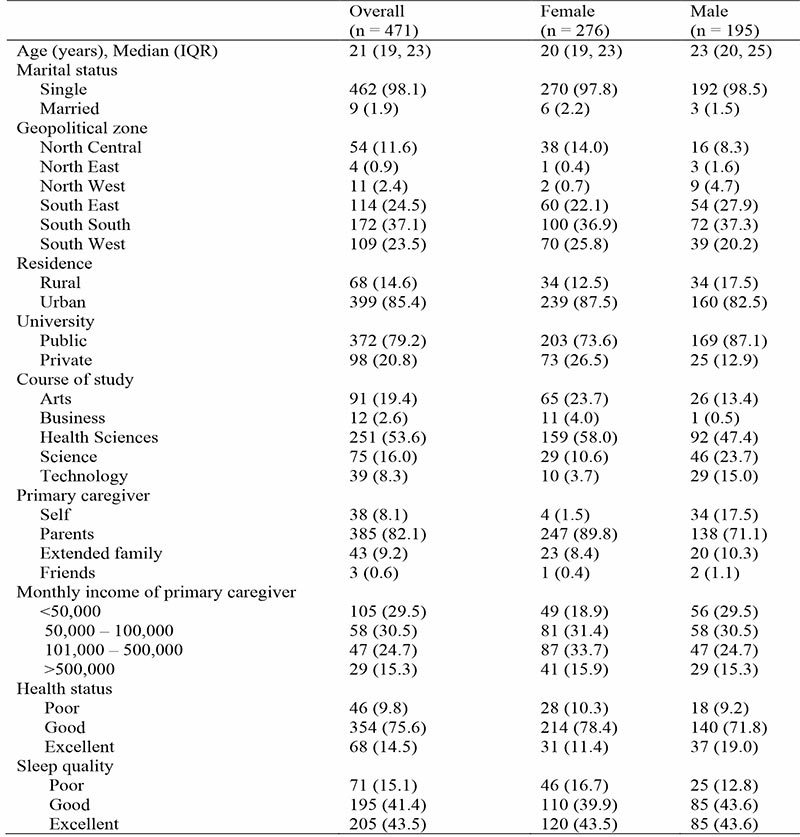
Prevalence of Perceived Stress
Figure 1 and 2 shows the prevalence of perceived stress in the study population by sex and age groups respectively. The prevalence of high stress was 15.9% and 11.9% among male and female participants respectively. The prevalence of moderate stress was 61.5% and 62.3% among male and female participants respectively. There was a discernible consistency in the pattern of prevalence of low, moderate, and high stress among participants aged 18-22, 23-27 and ≥28 years (Figure 2).
[caption id="" align="alignnone" width="800"]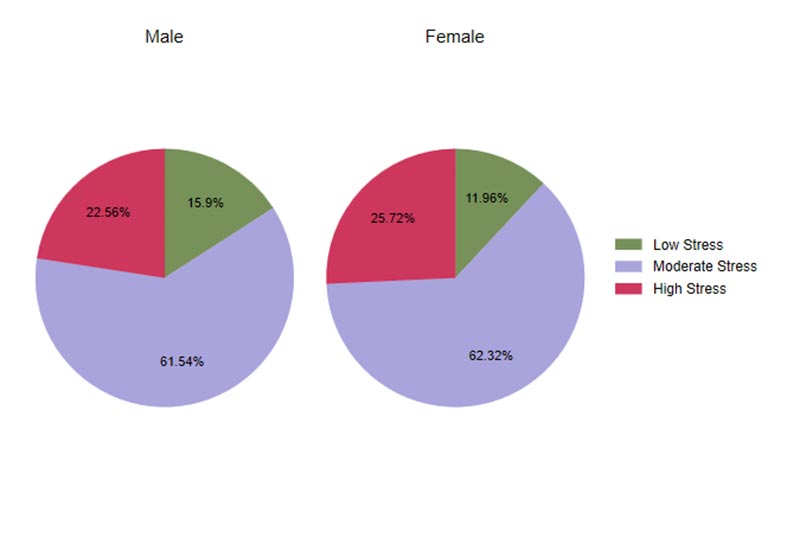 Figure 1: Distribution of Perceived Stress Scale (PSS) categories among undergraduate students in Nigerian universities, by sex (N = 471)[/caption]
[caption id="" align="alignnone" width="800"]
Figure 1: Distribution of Perceived Stress Scale (PSS) categories among undergraduate students in Nigerian universities, by sex (N = 471)[/caption]
[caption id="" align="alignnone" width="800"]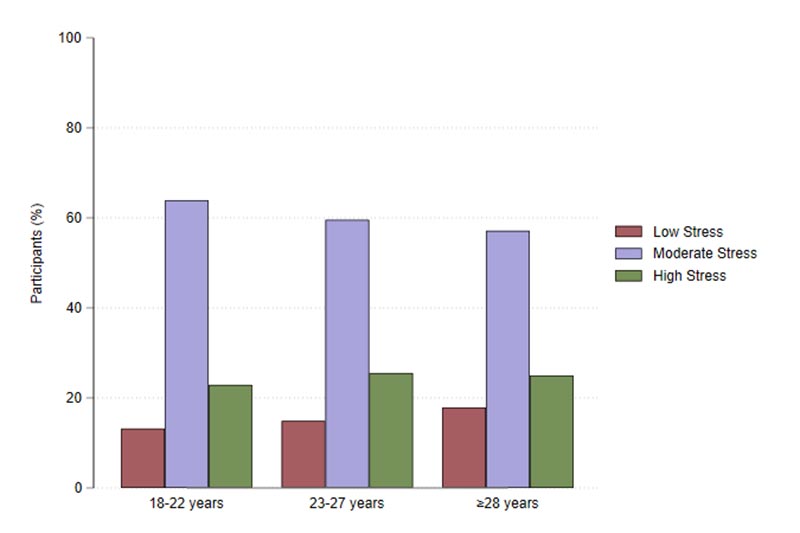 Figure 2: Distribution of Perceived Stress Scale (PSS) categories among undergraduate students in Nigerian universities, by age group (N = 471)[/caption]
Figure 2: Distribution of Perceived Stress Scale (PSS) categories among undergraduate students in Nigerian universities, by age group (N = 471)[/caption]
Predictors of Moderate and High Stress
Bivariate analysis assessing differences between categories of perceived stress (low, moderate/high) and participant characteristics showed statistically significant differences in health status, sleep quality, financial support, and perceived social support (p < 0.05).
The multivariable analysis demonstrated several predictors of reduced risk of moderate and high stress among the study participants. Good (aOR: 0.21, 95% CI 0.03 to 1.66) and excellent (aOR: 0.27, 95% CI 0.03 to 2.52) health status was significantly associated with reduced risk of moderate and high psychological stress. Excellent sleep quality was significantly associated with reduced risk of moderate and high psychological stress (aOR: 0.20, 95% CI 0.05 to 0.77).
Table 2: Characteristics of the study population by perceived stress categories (N = 471)
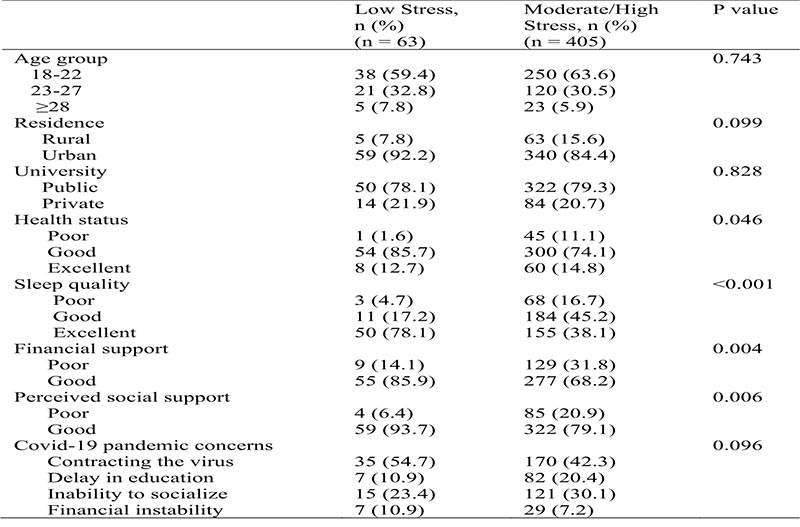
Table 3: Predictors of moderate and high stress among the study population (N = 471)
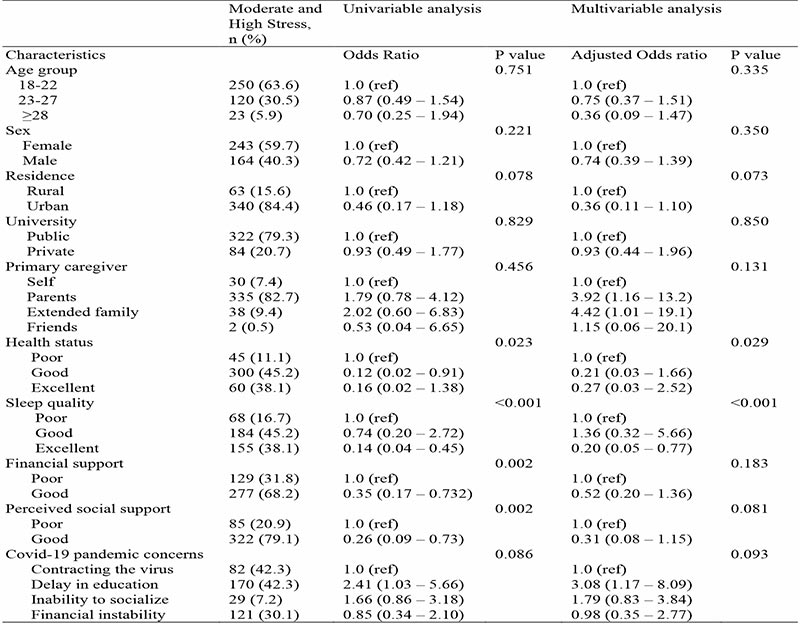
Discussion
The declaration of COVID-19 as a pandemic by the World Health Organization (WHO) on March 11, 2020, made it an important public health issue because of the number of persons and their families affected, coupled with concerns regarding the psychological consequences of quarantine, social isolation, financial strain, and the threat of infection.9-13 COVID-19 pandemic has severely impacted university students’ coursework, psychological stress levels, and mental health wellbeing. Recent studies have indicated that high proportions of university students have experienced increased amounts of psychological stress.12-14 University students being largely in the adolescent and early adulthood period may be a particularly vulnerable population for mental health challenges in the light of challenges commonly associated with transitions to adulthood.12,13,15.16
In this study, the prevalence of moderate and high psychological stress among university students was 86.4%, with the majority (62.0%), having moderate psychological stress. This is consistent with findings from previous studies. In a study carried out among university students in France during the COVID-19 lock down, a psychological stress level of 60.2% was reported with those not relocating to their caregivers being more affected.17 In China, a moderate to severe level of psychological distress of 53.8% was reported in the general population during the lock down, with female gender and undergraduate students being significantly more affected.18 In a similar study conducted among college students in China, during the COVID-19 outbreak, it was observed that 24.9% of the students experienced anxiety with urban residence, staying with parents and having a steady family income as protective factors.3
Our study demonstrated that financial and social support were critical factors associated with psychological stress. A large proportion of our respondents reported poor financial and social support from parents and caregivers. Financial and social support from parents and caregivers were found to be independent predictors of psychological stress. Absence of financial support may be due to the pandemic restrictions leading to loss of jobs and business opportunities as well as increased cost of living. This is likely to adversely impact on the families of participants with a lower socio-economic status. The economic consequences of COVID-19 disease have been reported on a global scale. Previous studies have demonstrated that individuals from lower socioeconomic backgrounds have experienced greater psychological stress during the COVID-19 pandemic.19-22
Moderate and high psychological stress levels among the study participants in our study may be related to the disruption in the daily activities and educational pursuit of university students in rather than health factors related to the transmissibility of the virus. A large proportion of the students in this study (43.9%) reported fears of delay in school as their greatest concern about the COVID 19 pandemic while fear of contacting COVID-19 was reported by 19.1% of our respondents. This suggests that the psychological stress among the respondents in our study may be attributed to accompanying setbacks due to the restrictions associated with the pandemic and not necessarily from fears of contracting the virus. The results also show that odds of developing psychological stress are significantly lower amongst students with good/excellent health status and sleep quality respectively. Previous research has shown that good health status and sleep quality are protective factors against psychological stress.23,24
This study has limitations. First, the cross-sectional nature of the study with a single period of data collection does not allow for causal inference. Also, the measures were assessed using self-reported questionnaires which had inflexibility in certain responses. This might lead to an overestimation or underestimation of measured variables by the respondents.
Conclusion
A high level of psychological stress exists in the university students’ population due to the ongoing COVID-19 pandemic. Psychological and public health strategies may be required to promote mental wellbeing in this community of people.
References
- NCDC Coronavirus COVID-19 Microsite, https://covid19.ncdc.gov.ng/ (accessed 24 May 2020).
- Esan O, Esan A, Folasire A, Oluwajulugbe P. Mental health and wellbeing of medical students in Nigeria: a systematic review. International Review of Psychiatry 2019; 31: 661–672.
- Cao W, Fang Z, Hou G, Han M, Xu X, Dong J et al. The psychological impact of the COVID-19 epidemic on college students in China. Psychiatry research 2020; 11:29-34.
- González-Sanguino C, Ausín B, Ángel Castellanos M, Saiz J, Lopez-Gomez A, Ugidos C.et al. Mental Health Consequences during the Initial Stage of the 2020 Coronavirus Pandemic (COVID-19) in Spain. Brain, Behavior, and Immunity 2020; 87: 172–176.
- Nwabufo BN, Umoru TA, Olukotun JO. The challenges of e-learning in tertiary institutions in Nigeria. International Conference.The Future of Education 2012, pp. 1-4. Florence (2012)
- Fisher A, Laing J, Stoeckel J. Handbook for family planning operations research design. Population Council, 1983.
- Aderibigbe YA, Gureje O. The validity of the 28-item General Health Questionnaire in a Nigerian antenatal clinic. Soc Psychiatry Psychiatr Epidemiol 1992; 27: 280–283.
- Ojobo HI. Validating the Measures of Perceived Restorativeness in Obudu Mountain Resort, Cross River State, Nigeria. Open Journal of Social Sciences 2014; 2: 1.
- World Health Organization. WHO Director General’s Opening Remarks at the Media Briefing on COVID-19. 2020. [Press release].
- World Health Organization: Considerations for quarantine of individuals in the context of containment for coronavirus disease (COVID-19). Interim guidance. WHO/2019-nCoVIHR_Quarantine/2020.2.2020a.
- Pfefferbaum, B., & North, C. S. Mental health and the COVID-19 pandemic. NewEngland Journal of Medicine. 2020;383: 510–512.
- Auerbach RP,Mortier P, Bruffaerts R, Alonso J, Benjet C, Cuijpers P. et al WHO worldmental health surveys international college student project: prevalence and distribution
of mental disorders. J Abnorm Psychol. 2018;127:623-638 - Rubley JN. The student-centered university: Pressures and challenges faced by college presidents and student affairs leaders. Oracle 2017 pages 7-8
- Auerbach RP, Alonso J, Axinn WG, Cuijpers P, Ebert DD, Green JG et al. Mental disorders among college students in the World Health Organization World Mental Health Surveys. Psychol. Med. 2016; 46: 2955–2970.
- Arnett JJ, Žukauskiene R, Sugimura K. The new life stage of emerging adulthood at ages 18-29 years: Implications for mental health. The Lancet Psychiatry,2014; 1: 569–576.
- Patel V, Flisher A J, Hetrick S, McGorry P. (2007). Mental health of young people: A global public-health challenge. Lancet, 2007;369: 1302–1313
- Husky MM, Koyess-Masfety V, Swendsen JD. Stress and anxiety among university students in France during Covid-19 mandatory confinement. Comprehensive Psychiatry, 2020; 102:152-191
- Wang C, Pan R, Wan X, Tan Y, Xu L, Ho C S, et al. Immediate psychological responses and associated factors during the initial stage of the 2019 coronavirus disease (COVID-19) epidemic among the general population in China. Int. J. Environ. Res. Public Health 2020;17:17-29.
- Lee-Baggley D, DeLongis A, Voorhoeave P, Greenglass E. Coping with the threat of severe acute respiratory syndrome: Role of threat appraisals and coping responses in health behaviors. Asian Journal of Social Psychology. 2004; 7: 9–23.
- Ahmed F, Ahmed N, Pissarides C, & Stiglitz J. Why inequality could spread COVID-19. The Lancet Public Health. 2020; 5: e240.
- Buheji M, da Costa Cunha K, Beka G, Mavrić B, Leandro do Carmo de Souza Y, Souza da Costa Silva et al. The extent of COVID-19 pandemic socioeconomic impact on global poverty: A global integrative multidisciplinary review. American Journal of Economics, 2020; 4: 213–224
- Frasquilho D, Matos M G, Salonna F, Guerreiro D, Storti C C, Gaspar T et al. Mental health outcomes in times of economic recession: A systematic literature review Health behavior, health promotion and society. BMC Public Health. 2016; 16:115.
- Zhang, C., Xiao, S., Lin, H. et al. The association between sleep quality and psychological distress among older Chinese adults: a moderated mediation model. BMC Geriatr 2022; 22:35. https://doi.org/10.1186/s12877-021-02711-y
- Brooke R. Leonelli, Tyler Kuhn & Joel W. Hughes (2023) Sleep quality and mental health during COVID-19: the role of distress tolerance, Psychology, Health & Medicine, 2023; 28:4: 929-937, DOI: 10.1080/13548506.2022.2083644cta Orthop Scad. 2003; 74: 665-669.